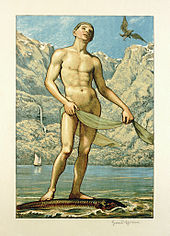Algraphy

Algraphy is a flat printing process for book illustration , which in its further development to offset printing is one of the most important lithographic processes today. The algraphy was developed around 1890 by Karl Scholz, head of the Mainz publishing house Jos. Scholz, the patent was awarded to Jos. Scholz granted in 1892/93. The word algraphy is a short form of aluminum and the Greek graphein = to write. In contrast to lithography , algraphy does not use a stone but a grained aluminum plate. There is also a similarity in the processing for etching on copper, whereby the etching can be omitted (algraphic etching). The working materials (litho chalk, lithofine, ink, pencil, pen, etc.) and the working method correspond to those of lithography on stone or on the processing of the copper plate.
literature
- Weilandt, Carl: The aluminum print: Algraphy. Its establishment and exercise in lithographic practice. Vienna around 1902.
- Malz, Sebastian (Hrsg.): The techniques of algraphy: with special consideration of the artistic production processes of every kind u. Treatment of the same in print. Berlin-Schöneberg around 1910.
Web links
- Algraphy in the art lexicon of PW Hartmann
- Algraphy . In: Meyers Großes Konversations-Lexikon . 6th edition. Volume 1, Bibliographical Institute, Leipzig / Vienna 1905, p. 327 .